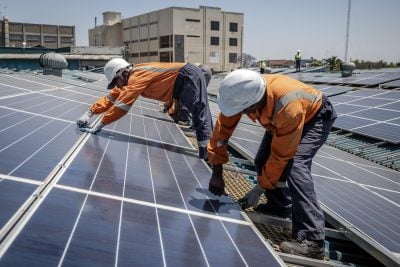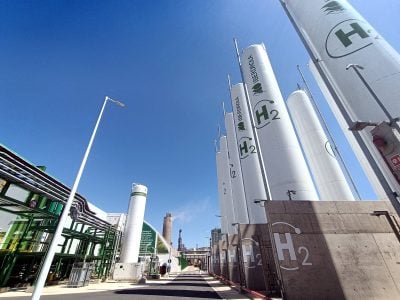Pressure is increasing on African countries to help tackle climate change by reining in their greenhouse gas (GHG) emissions and resisting the temptation to develop new oil and gas fields. Yet Africa accounted for just 4% of global GHG emissions between 1990 and 2017 despite the fact that it contains 17% of the world’s population.
In addition, African per capita emissions are about a fifth of the global average, leading critics to complain that radical action on the continent will stifle potential economic development for a problem that has largely been created elsewhere.
That has prompted a debate over whether richer countries should compensate Africa in order to keep its fossil fuels in the ground. The US has announced that it will quadruple its international climate finance to $11.4bn by 2024 to help developing countries cope with global warming but much more international investment in solar power, onshore wind, offshore wind and perhaps hydrogen is required if Africa is to forego its interest in dirty fuel extraction.
Oil has long been one of Africa’s main export commodities, generating billions of dollars in revenue every year but also tempting governments to rely on hydrocarbon export revenues at the expense of developing a more diverse economic base.
Still, the international trend is unmistakeable. As oil companies look to diversify, they themselves admit that production has already begun a long-term decline, with Shell predicting an 18% fall in its output over the course of the current decade.
The big question is whether governments and the oil and gas sector are prepared to leave hydrocarbons stranded. Carbon capture utilisation and storage (CCUS) technology would allow oil and gas production to continue while producing far fewer emissions, yet there are real doubts over whether the added costs of CCUS will ever allow hydrocarbons to compete on price with renewables.
Natural gas may have a rosier medium-term outlook. Considered by some to be a bridging fuel between hydrocarbons and renewables, it is likely to play a role in the power generation mix for the foreseeable future, despite considerable carbon and methane emissions during production, transporation and usage.
Indeed, a large proportion of the extractive industry’s emissions come from the power consumed during oil and gas production. The average offshore platform needs generating capacity of 50-100 MW, usually provided by natural gas but increasingly backed by renewables. The UK, for instance, has launched a tender for massive offshore wind farms to supply its offshore oil and gas industry.
The same transition could be adopted by African producers, safe in the knowledge that any renewable energy projects developed for the purpose can be used for grid supply or hydrogen production when fields become exhausted or are phased out.
Defence of hydrocarbons
As might be expected, both Opec and the African Petroleum Producers Organisation (APPO) want to see Africa’s renewable energy potential developed alongside hydrocarbons, not instead of them.
At a meeting in Brazzaville in September, APPO secretary-general Omar Farouk Ibrahim said: “We will not allow billions of barrels of oil to go to waste and we will not be bamboozled into projects that we don’t need – ones which will not address energy poverty. We need to sit down and have an honest conversation about the energy transition.”
Opec secretary-general Mohammed Barkindo agreed, arguing: “We in Opec also categorically reject the narrative that the energy transition is from hydrocarbons to renewables because this narrative is completely misrepresenting science.”
The African Energy Chamber has gone one step further, calling for African countries to boycott companies that block fossil fuel investment. “Financial institutions that discriminate against Africa’s oil and gas industry in the name of climate change are wrong and desperately need to change both their mindsets and actions,” it said in a statement issued in July.
Yet an increasing number of institutional investors and banks are doing just that, so the smaller oil and gas companies who have traditionally identified new finds before developing them or selling them on to the big players are finding it difficult to secure funding.
There are growing fears in the industry that a large proportion of African oil and gas reserves will never be tapped. Forecast falls in oil investment may have finally enabled the passage of Nigeria’s Petroleum Industry Act (PIA) earlier this year. After two decades of trying, the government finally managed to pass the redrafted legislation, which aims to produce a profound transformation in the Nigerian oil and gas sector.
The Act sets out new terms of investment on both exploration and production, while offering more commercial rates for natural gas production in an effort to ensure that gas is marketed within the country rather than being flared.
Abuja has set a target of boosting oil production from an average of about 1.6m barrels per day (b/d) at present to 4m b/d as a result of the PIA’s passage but such targets have been set before to little effect. Still, the PIA’s passage is a sign that the country is keen to exploit its resources properly before the world turns inexorably against fossil fuel.
Gas expansion
In contrast with the oil sector, demand for gas is continuing to rise, partly in order to compensate for the slower development of coal-fired power plants.
The International Energy Agency forecasts a 3.6% rise in global gas demand this year as the recovery from the Covid-19 economic shock continues, followed by average annual growth of 1.7% over the next three years. Forecast rising consumption means that there should still be scope for new African liquefied natural gas (LNG) projects, including those planned in Mozambique and Tanzania.
Plans for the Trans-Saharan Gas Pipeline from Nigeria through Niger to Algeria have also been revived by the Algerian government, which is keen to maximise its exports to Europe. Poor relations between Morocco and Algeria make the construction of new subsea capacity from Morocco to Spain less likely but Algeria could build on its existing pipeline links with Italy.
The biggest new gas field under development is the Zohr field in Egypt, which is considered the biggest ever gas find in the Mediterranean with estimated reserves of 30 trillion cubic feet. Operator Eni has already ramped up production to 3.2bn cu ft/day since the first gas was produced in 2019. The development of Zohr and other new fields has enabled Egypt to halt its LNG imports, increase its own LNG exports and consider new piped gas exports.
New directions for oil companies
Even if carbon capture and storage become more popular, there is little doubt that oil companies need to identify other profitable streams. Offshore wind can be used to produce hydrogen, even on the turbine platforms themselves, with the resulting hydrogen piped onshore using existing gas pipeline networks.
The process has begun in Africa, where the biggest planned hydrogen project under consideration is a 10 GW scheme in Mauritania that would be powered by Africa’s first offshore wind farms as well as solar power.
The proposals are currently at an early stage of development but the developer, oil firm Chariot, has been granted exclusive development rights over a huge area of offshore acreage, plus two onshore blocks, covering a total of 14,400sq kmto carry out pre-feasibility and feasibility wind and solar power studies.
There is currently little international trade in hydrogen but Mauritania would be well placed to export cargoes to European customers if – as expected – the market does take off.
Australia’s CWP Global also hopes to develop an integrated solar-wind-hydrogen project in Mauritania, with the country seen as an ideal focus because of its combination of excellent wind and solar resources.
New project pipeline continues
Investment in exploring new acreage and developing new oil projects will increasingly slow over the next decade, yet huge volumes of crude oil will continue to be produced for vehicle fuel and industrial uses. Despite climate-related financing constraints, some oil companies still have the financial muscle to seek out new acreage and develop new projects.
For instance, the licensing round for nine new onshore blocks in Angola attracted 45 bids from 15 companies by the time the round closed in June. Luanda is keen to see new fields developed to help reverse the fall in national output over the past few years.
Opaque terms of investment and the challenge of developing ultra deepwater fields deterred investment under the previous administration but President João Lourenço is seeking to establish a new relationship with foreign investors. In April, Eni announced that its Cuica oil discovery offshore Angola could hold up to 250m barrels, which it intends to develop in conjunction with other deepwater finds.
The government also hopes to sell a 30% stake in state oil company Sonangol next year via an initial public offering as part of a wide ranging privatisation process. Many of Sonangol’s non-oil assets have been offered for sale, although demand for them has been limited, while it is also divesting stakes in some offshore blocks, as Luanda tries to produce a slimmed down, more commercially minded company.
When will East Africa’s oil and gas boom begin?
East Africa’s long awaited oil and gas boom has been frustrated at every turn. TotalEnergies, China National Offshore Oil Corporation and the Uganda National Oil Corporation aim to produce 230,000 b/d on their Lake Albert project, which includes the development of the Tilenga and Kingfisher fields.
However, the governments of Uganda and Tanzania have still not passed all the required legislation, including on the construction of the 1,445km East Africa Crude Oil Pipeline, which will run to the northern Tanzanian port of Tanga.
The project has been held up for several years because of disagreements over tax levels and other contract terms.
Kenya too hopes to join the ranks of Africa’s oil producers, when Tullow Oil and Africa Oil develop the Turkana project in the South Lokichar Basin. There are 585m barrels of oil in place and production is expected to peak at 120,000 b/d but the two companies still need to bring other partners on board to help finance development. As with the Ugandan project, a pipeline is required to transport the oil to the coast, in this case to Lamu.
The prospects of Tanzania’s LNG project being developed have increased since Samia Suluhu Hassan replaced John Magufuli as the country’s president in March after the latter died. Talks with developers Shell and Equinor were ended in 2019 because of Magufuli’s demand that the existing production sharing agreement be rewritten to restrict income repatriation.
Hassan appears more amenable to striking a deal but the investors have warned the government that the time for developing new gas projects is limited.
Read more about oil and gas in our special report on the future of the African energy sector.
Want to continue reading? Subscribe today.
You've read all your free articles for this month! Subscribe now to enjoy full access to our content.
Digital Monthly
£8.00 / month
Receive full unlimited access to our articles, opinions, podcasts and more.
Digital Yearly
£70.00 / year
Our best value offer - save £26 and gain access to all of our digital content for an entire year!
 Sign in with Google
Sign in with Google 



